The 2022 edition of the Allsvenskan is in full swing now, with the midway point of the season approaching in the coming weeks. In the most recent round of fixtures, Djurgårdens recorded a 1-0 over Hammarby – both teams are currently trying to mount a push for a finish in the top three to secure European football for next season, either in the UEFA Champions League or the Europa League. Three points for Djurgårdens lifted them to second in the table, just a point behind current leaders Häcken.
This tactical analysis will put a scope on why Djurgårdens were able to overcome Hammarby – the key elements that enabled them to their approach, as well as an analysis of the tactics that let them come away with a clean sheet.
Lineups
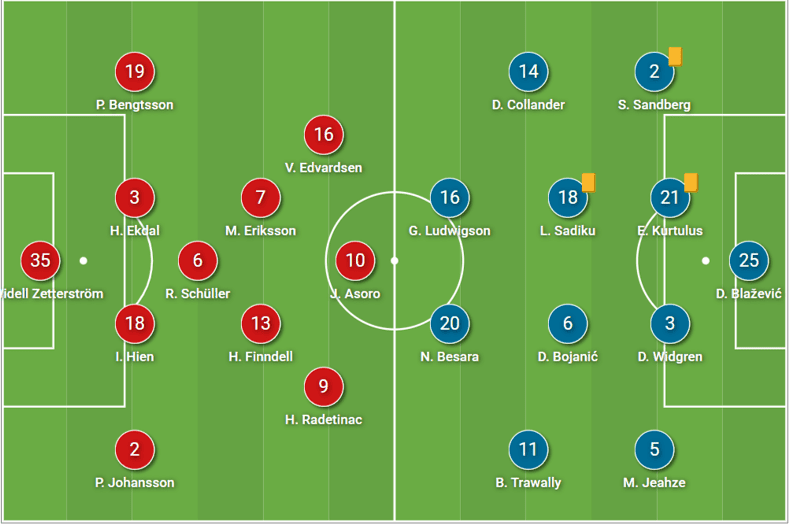
Djurgårdens co-managers Kim Bergstrand and Thomas Lagerlöf deployed their side in a 4-3-3 formation. A flat back four consisted of Piotr Johansson (RB), Isak Hien (RCB), Hjalmar Ekdal (LCB), and Pierre Bengtsson (LB), protected by the goalkeeper Jacob Widell Zetterström.
In midfield, the hosts opted for one deeper player, allowing the two remaining midfielders to offer more assistance in possession and in the attack. Former MLS player Rasmus Schüller was the one providing defensive cover in the middle, with Hampus Finndell and captain Magnus Eriksson operating higher up. On the flanks, Victor Edvardsen and Haris Radetinac provided the width with Joel Asoro leading the line. Asoro has a travelled CV, especially at just 23 years old, with a record that boasts experience in the Premier League, EFL Championship, and Eredivisie to name a few.
Meanwhile, visitors Hammarby were set up in a 4-4-2 shape by head coach Martí Cifuentes. Simon Sandberg (RB), Edvin Kurtulus (RCB), Dennis Widgren (LCB), and Mohanad Jeahze (LB), who is a reported target for Celtic, made up the back four. In midfield, skipper Darijan Bojanic partnered Loret Sadiku in the centre, with Dennis Collander and Bubacarr Trawally operating on the flanks. Nahir Besara and Gustav Ludwigson lead the line for the away side.
Hammarby look to dictate play
Judging purely by the base stats of the game, you would expect Hammarby to score. Combining this with their clear understanding of their tactical approach, it becomes even more surprising that they failed to find the back of the net. Below is an analysis of how a typical build-up phase would look for them, including their ability to incorporate a counter-attacking element into their game. We will also discuss why their efforts didn’t pay off in this fixture.
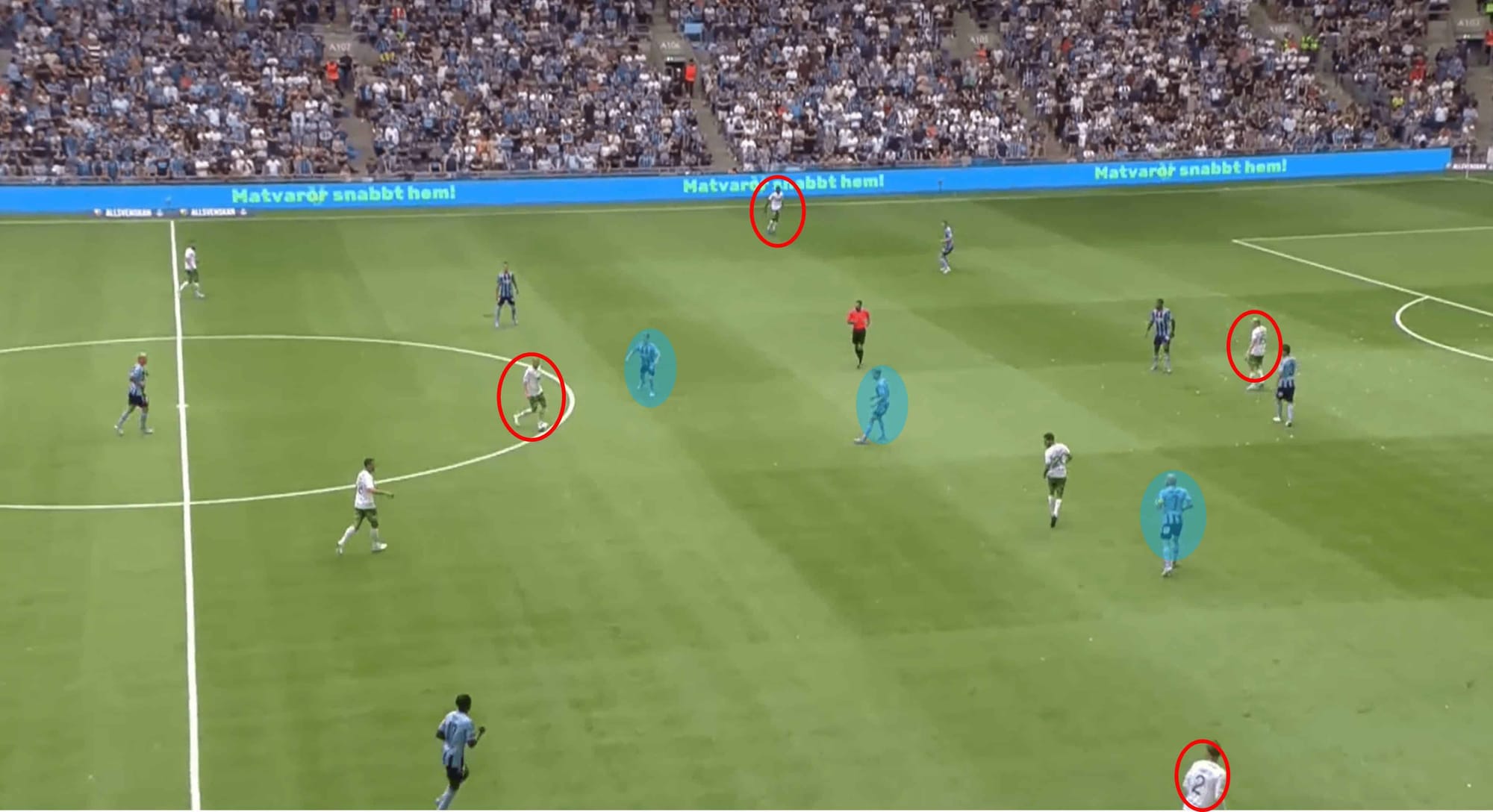
Above is an example of Hammarby having comfortable possession in the Djurgårdens half – one of many examples too. Hammarby recorded 64.49% possession during the game, which shows they had confidence and an understanding of how they were instructed to play. However, there is a slight twist of Hammarby’s possession-dominant approach, which you can see above. They use possession to gain yards into the opposition half, but once they enter the final third, the approach alters, with the focus shifting to delivering crosses into the area. There will be a further analysis of this tactical style deeper into the report.
Despite dominating possession being an important tactical component in this game for Hammarby, they were also very keen to keep the ball moving, preferably forward – they made 565 passes in this game, compared to Djurgårdens’ 242, which shows how much of the ball they saw. When you dive deeper into their passing data, you can see their attacking intent – 75 of those passes were made into the final third, while Djurgårdens only made 37 passes into the final third.
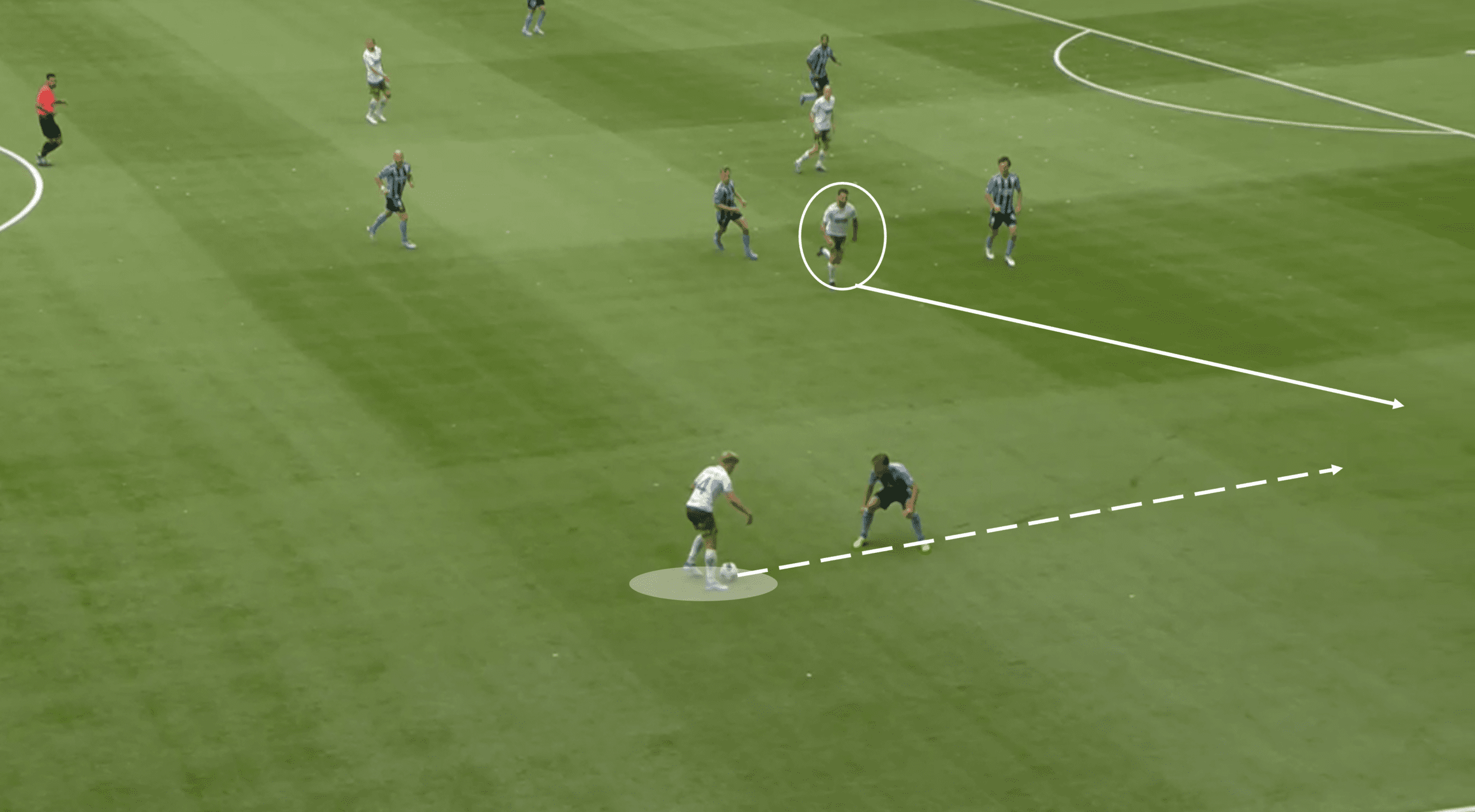
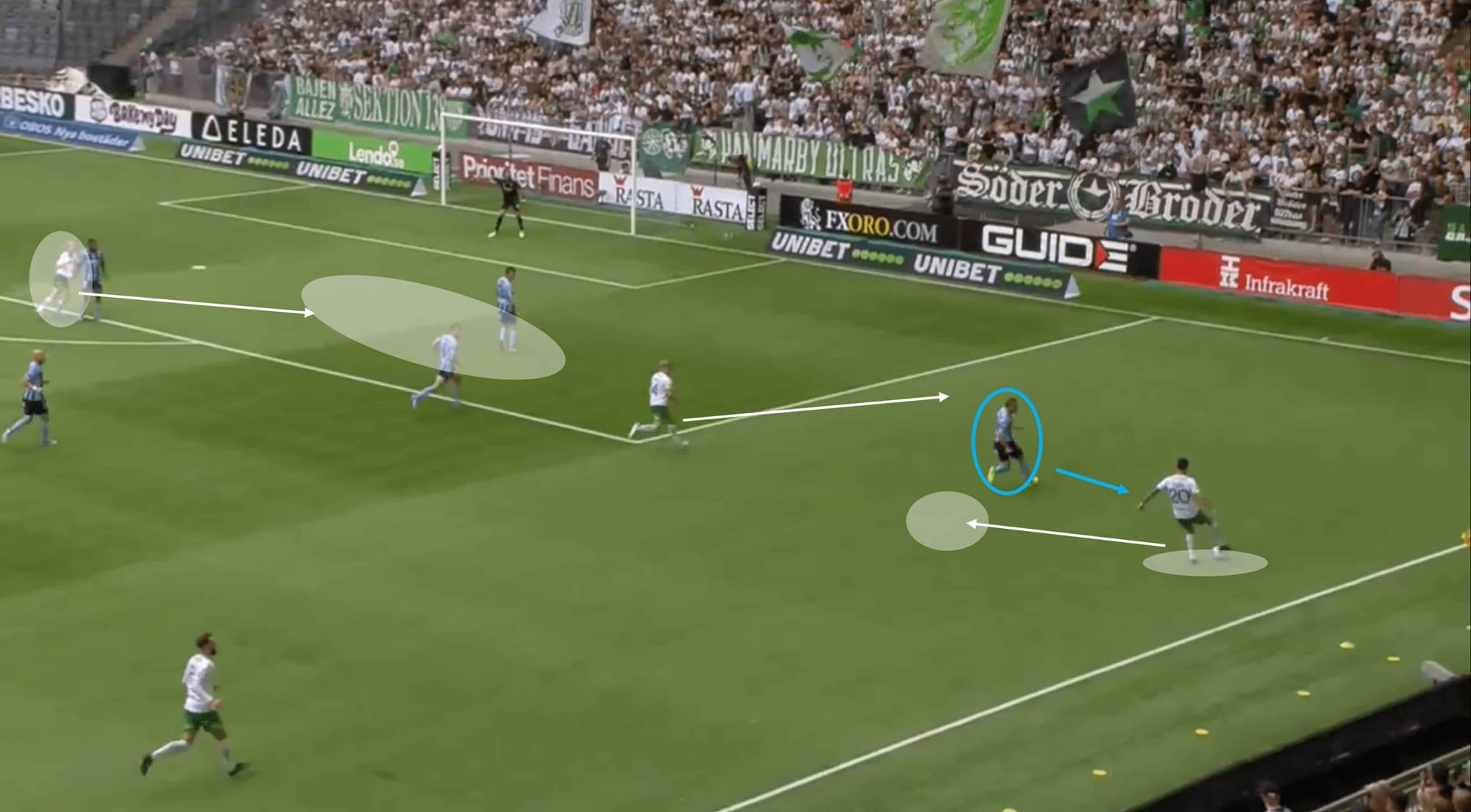
Above is the aforementioned analysis of Hammarby’s interesting wide play. It begins with possession in the midfield third following a recent transition. The player on the ball, Collander, is faced with a one-versus-one situation. His teammate, however, makes a clever run into the space left by the Djurgårdens left-back who vacated his original position to confront Collander. From here, there are strengths and weaknesses shown by both sides.
The man on the ball in the second image is Besara, and he is faced with two options: play the pass into the path of Collander or use his run as a decoy and cut inside to open up for a cross. Wisely, he opts for the second action.
The Djurgårdens defender is at fault in the second image as he faces up to Besara but leaves the Hammarby man with far too much room to operate in – he should’ve got closer to increase the pressure. Once Besara stepped inside, he curled a low cross into the highlighted zone in the box to try and meet the run of this attacking teammate, but it was defended.
As mentioned, crossing was a regular feature for the away side, with no fewer than 28 crosses – over triple the number of crosses from the hosts (9). The delivery of crosses was often of a good enough quality – or at least they would’ve been if Hammarby had a higher presence within the box. On multiple occasions, crosses were angled into the box with just one attacker in the box.
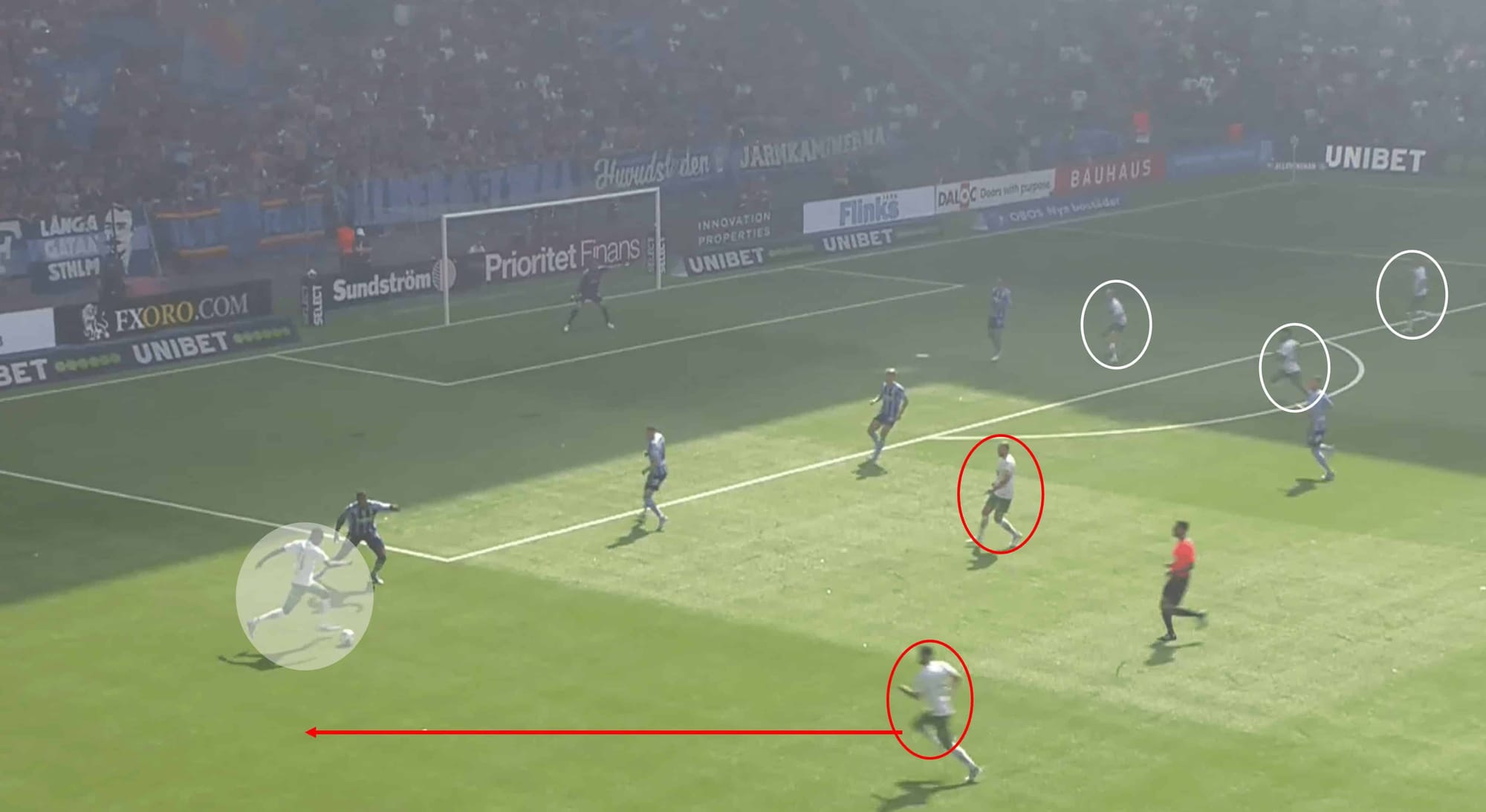
Hammarby can also be a threat on the break – albeit they only showcased this threat once in this match. Following a transition, an attacking possibility opened up for them and they had a strong presence in midfield, and thus the counterattack was launched. With three options coming in towards the far side, one player overlapping the winger, and one midfielder offering close support, Hammarby would have been extremely disappointed to have thrown this opportunity away.
Djurgardens’ attacking threat
Having just discussed Hammarby’s possession domination, Djurgårdens’ approach differed from this, opting to try and soak up the pressure and hit their opponents on counterattacks and in transition situations. Below, we look at the various tactical approaches taken by the eventual victors in attack.
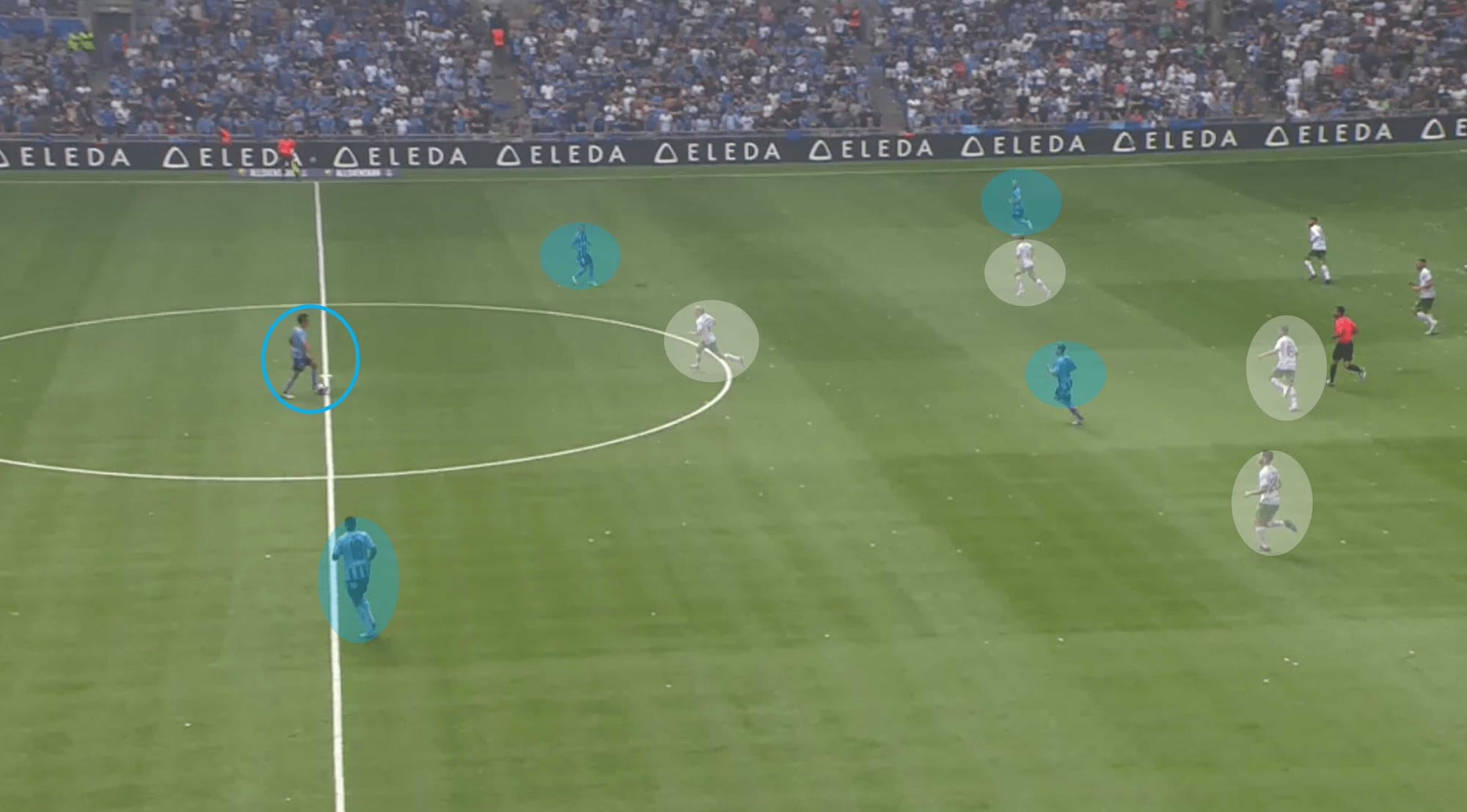
While it is true that Hammarby were the team to dictate a lot of the play, there were stages of the game where Djurgårdens were the side comfortable in possession and looked for individual awareness and creativity to unlock a fresh path of attack. Above is an example of this. The Djurgårdens centre-back has possession under no pressure with a good number of passing options at his disposal, but he takes his time and picks what was possibly the best pass he could’ve chosen in this situation.
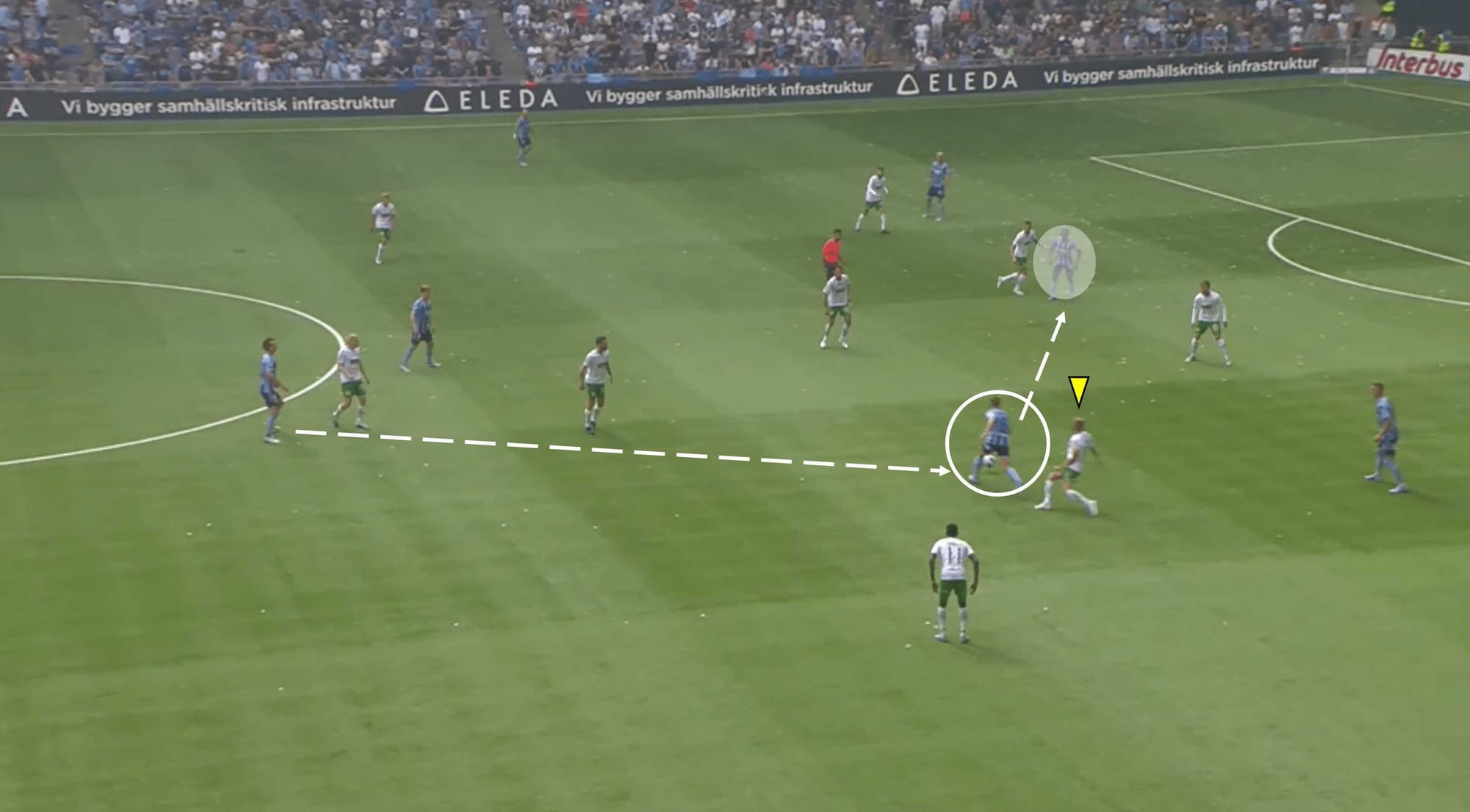
As you can see, the Djurgårdens man drifted into a good location where he could receive the pass and deploy good agility to turn into the space that would also allow him to progress the attack further. Questions should be asked of the Hammarby midfielder whose marking allowed his opponent to bypass the midfield line so easily, but credit must also go to the creativity and awareness. His pass into Asoro was a crisp one, and despite some clever dribbling and movement from the striker, he was unable to finish the move off.
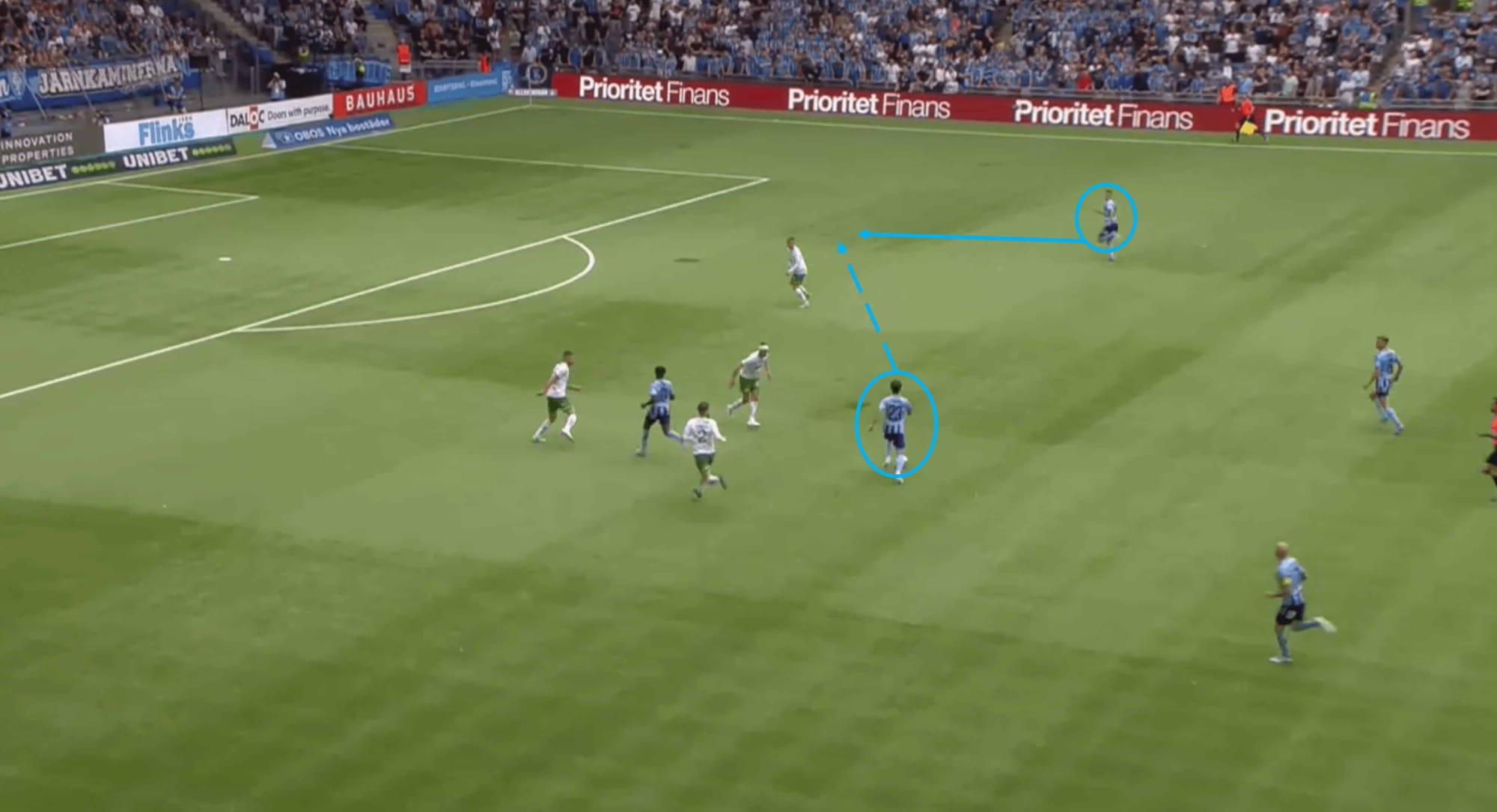
Djurgårdens’ main tactical approach during the game was to hit Hammarby with counterattacks or fast moves during a transition, and the example above shows Djurgårdens at their finest in this area. Following a turnover in possession on the left flank at the halfway line, Hammarby were caught with a lot of their players still in advanced positions, and the Djurgårdens attack and midfield units were ready to pounce. With runners in all directions, one pass was essentially the correct one to continue the flow of the move, and right-winger Radetinac received the ball upon approach to the penalty area. The continued analysis below shows how the veteran’s awareness and decision-making were key in the move and the goal that followed.
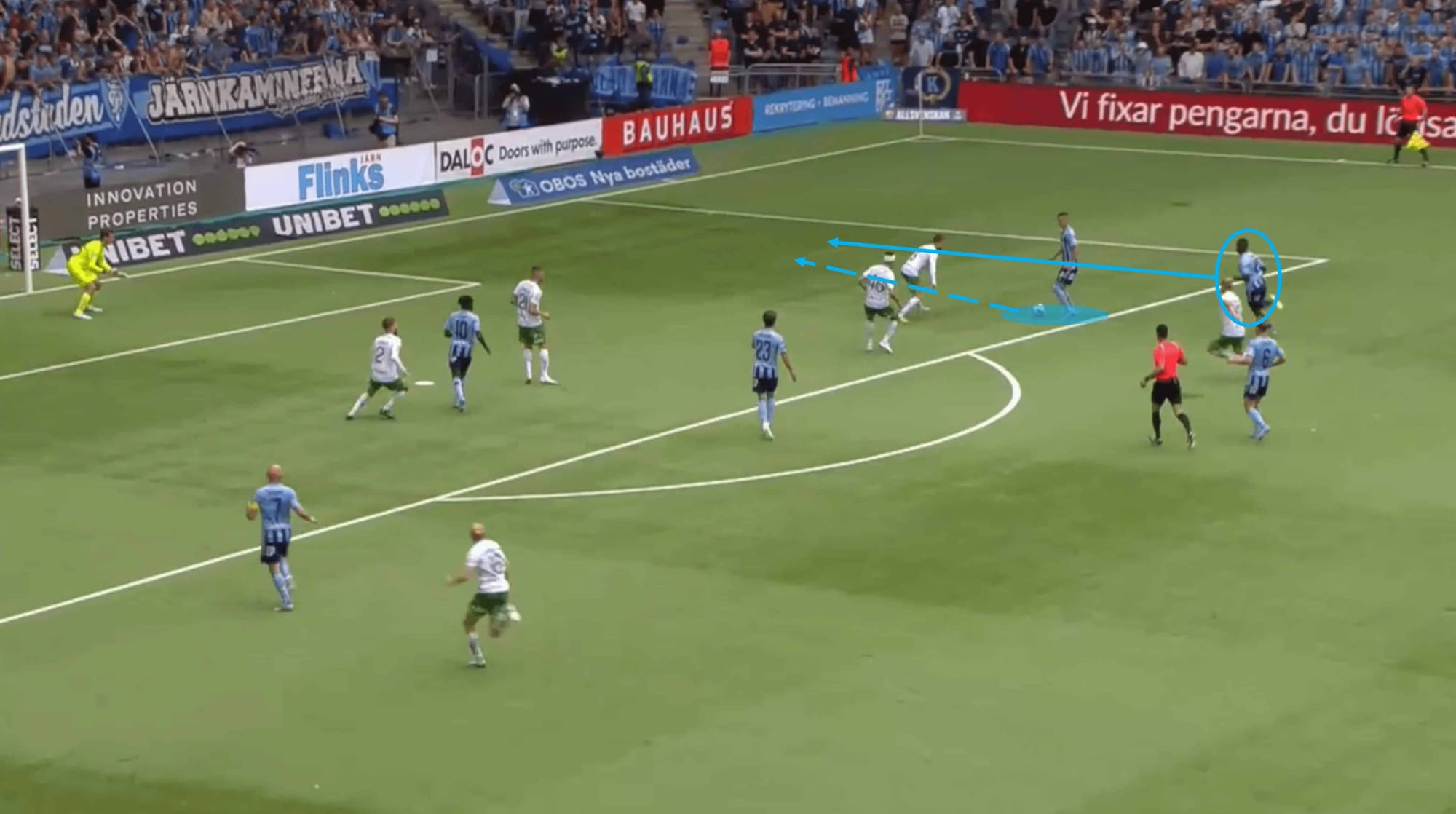
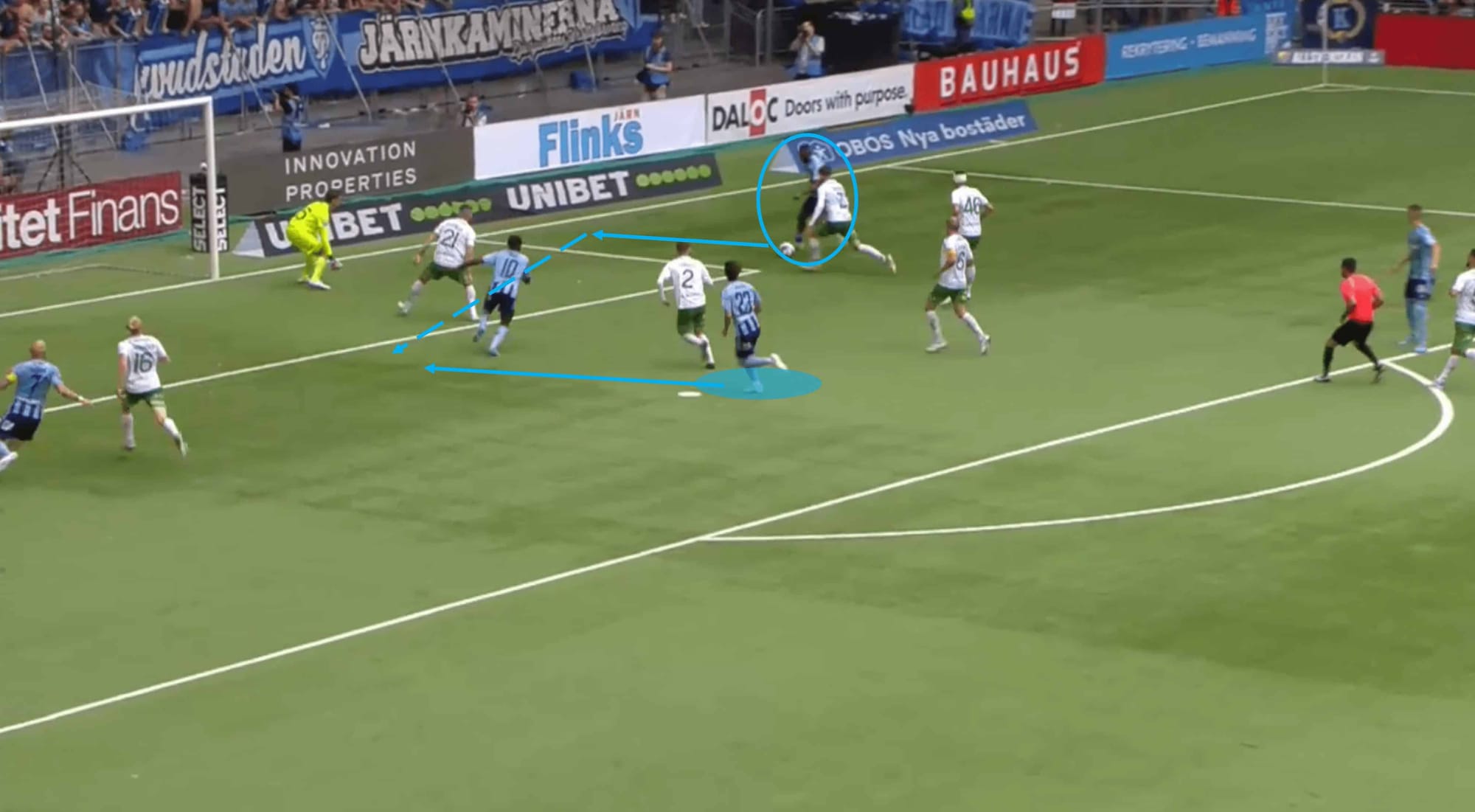
The overlapping run from substitute Emmanuel Banda provided a good option for Radetinac due to the lack of defensive presence, and he showed a good pace getting into position. He also showed good composure and technical ability to receive the ball in such a high-pressure situation at such a pace where he carried the ball towards the edge of the six-yard box before pulling the ball back towards fellow sub, Gustav Wikheim, who was able to simply cushion the ball into the empty goal. The end to this counterattack was a display of good team cohesion and tactical understanding which clearly carries through the squad past the starting lineup. Djurgårdens made three genuine counterattacks during the game – with more coming from transitions and other attacking scenarios.
They have a clear ability to sense danger once they reach the attacking third and they are able to capitalise on that and make good progress into the box. Djurgårdens’ average shot distance was 13.42 yards, which when compared to Hammarby’s average of 19.92 yards, tells you how dangerous the hosts can be if a team is caught out. Their xG of 3.04 also tells you that the shots posed genuine menace and weren’t just pot-shots – despite Hammarby’s possession, Djurgårdens may feel like they could’ve scored two or three on the day.
Djurgarden off the ball work
Coming into the game prepared and knowledgeable about your opponent is key, and a given in football, but applying that knowledge and preparation into a game plan is another thing entirely. Djurgårdens’ performance in this fixture points towards extensive work done in preparation for the game to allow the squad to understand how Hammarby will play and how they can try and stop it. Below, we analyse the defensive tactics put into play along with an analysis of some strengths and weaknesses.
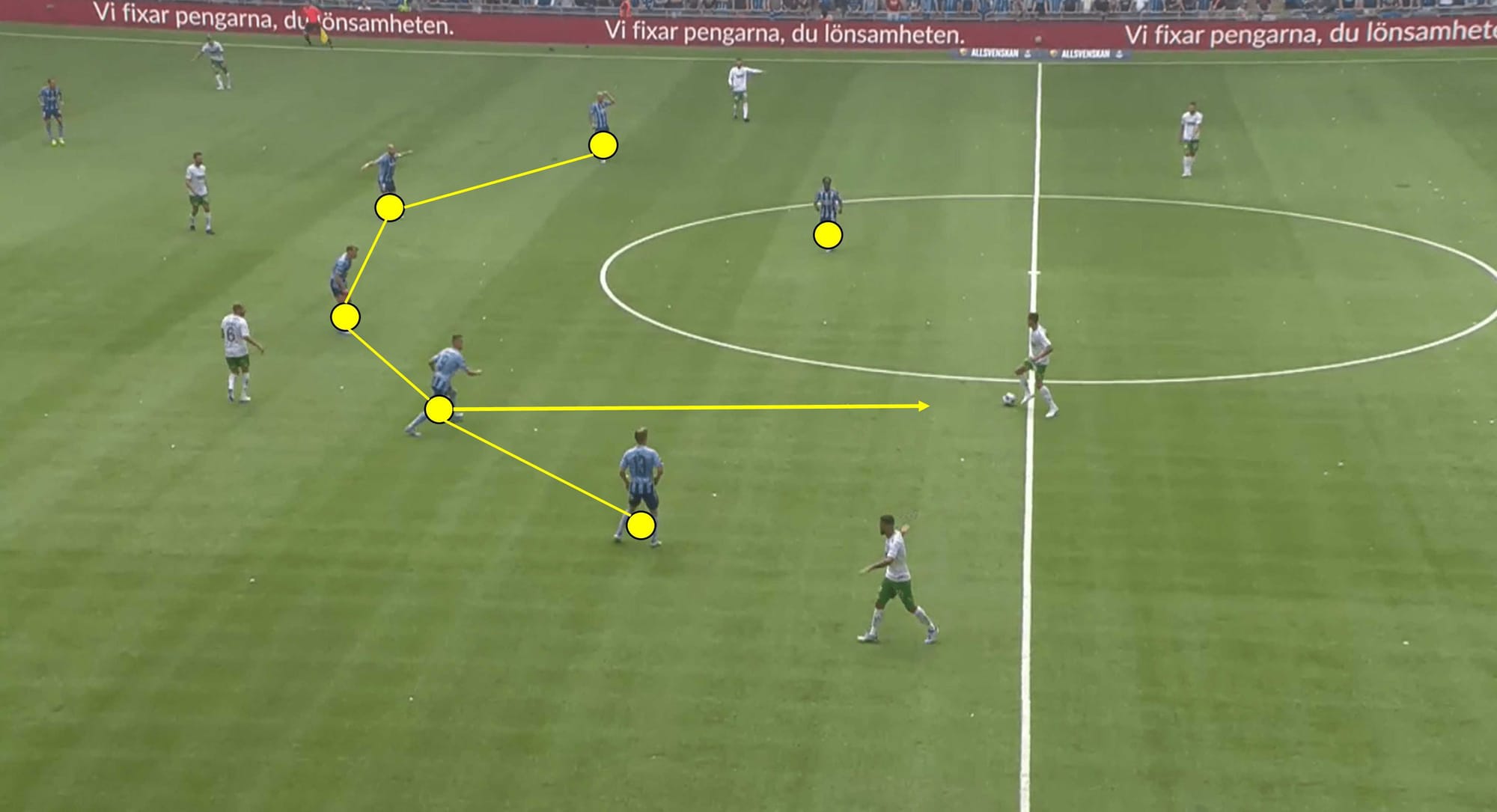
The shape is vital when applying a mid-block and the possession lies at the halfway line – the midfield unit must remain intact with a clear understanding of their individual and unit roles. Djurgårdens succeeded at most of these things – their shape in the middle is strong and compact, offering very little chance for Hammarby to play through them. However, one player, for reasons unknown, takes it upon himself to abandon the setup and apply pressure on the man on the ball. If Djurgårdens wanted pressure applied at this moment, it should’ve come from Joel Asoro as he is the highest man forward and his pressing would not open up space for the opponent to penetrate. The following parts of this move are analysed below.
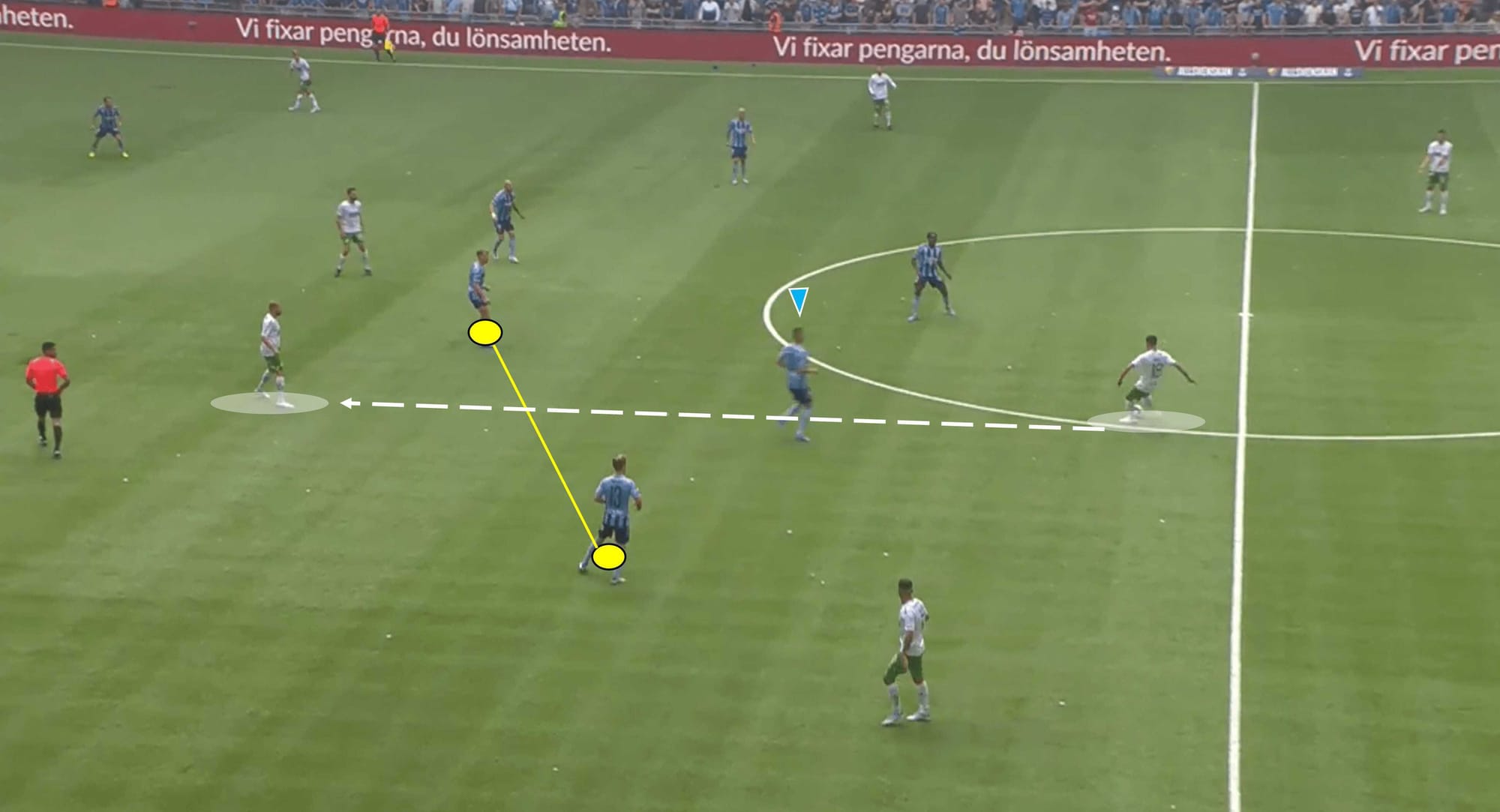
Once the Djurgårdens man leaves his post in the mid-block setup, he leaves a sizable gap which Hammarby immediately play through. The Hammarby man breaks the midfield line with a fizzed pass into the attacker who is unmarked as he receives the ball. Luckily for Djurgårdens, his control slightly lets him down and his pass to a teammate in attack is quickly snuffed out by a Djurgårdens defender. From the managers’ point of view, it must have been incredibly frustrating to see their defensive tactics executed well one moment and practically destroyed by one of your own players the next.
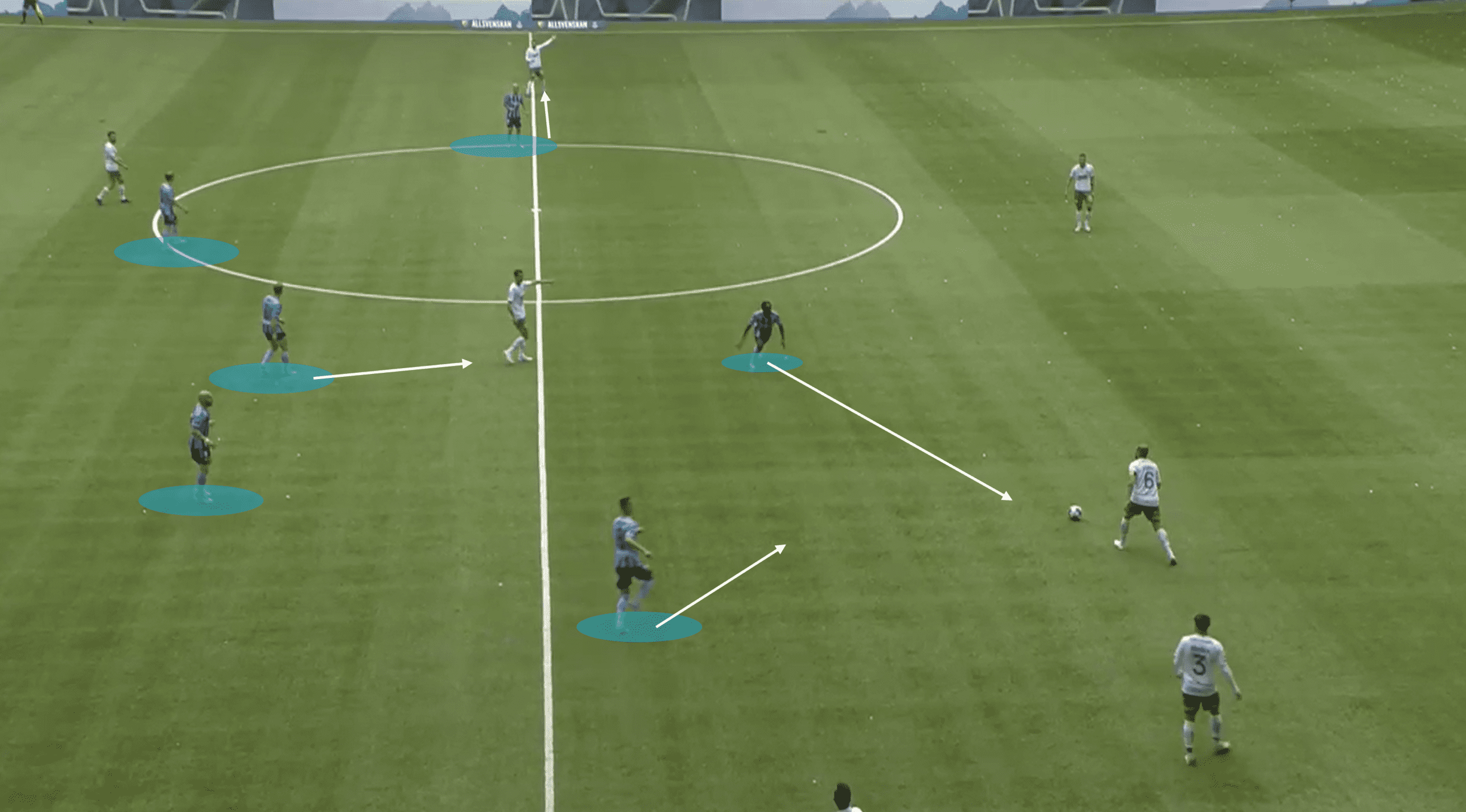
Above is an example of Djurgårdens setting up a unit block to stop Hammarby from playing forward, and actually maintaining strong positioning and shape until the opponents take their chance with a long ball. The individual positioning of the hosts in this scenario is pivotal – the midfielders are compact enough, but the left-sided midfielder’s position allows him to cut off the switch option for Hammarby. Other Djurgårdens midfielders are either occupying spaces that could be of potential danger or marking a passing option.
The two closest players are applying pressure to Bojanić, the man in possession, forcing him into making a move – a long pass that eventually results in his side losing the ball.
Defending with these tactics that rely on teamwork and communication is part of the reason why Hammarby struggled to offer any sustained threat throughout the game, and part of the reason they only recorded an xG of 1.3.
Conclusion
Contrasting tactics made for an open and somewhat unpredictable game, as well as providing evidence that possession alone does not win football matches. Both sides showed confidence in their respective tactical approaches, but it was Djurgårdens who showed a stronger execution this time. A counterattack system that doesn’t rely on parking the bus but instead looks to expose opposition weakness higher up the pitch is a good way to stifle your opponent. Hammarby are unlikely to ditch their method of hitting crosses into the box, but they may look at slight tweaks that could improve its efficiency.

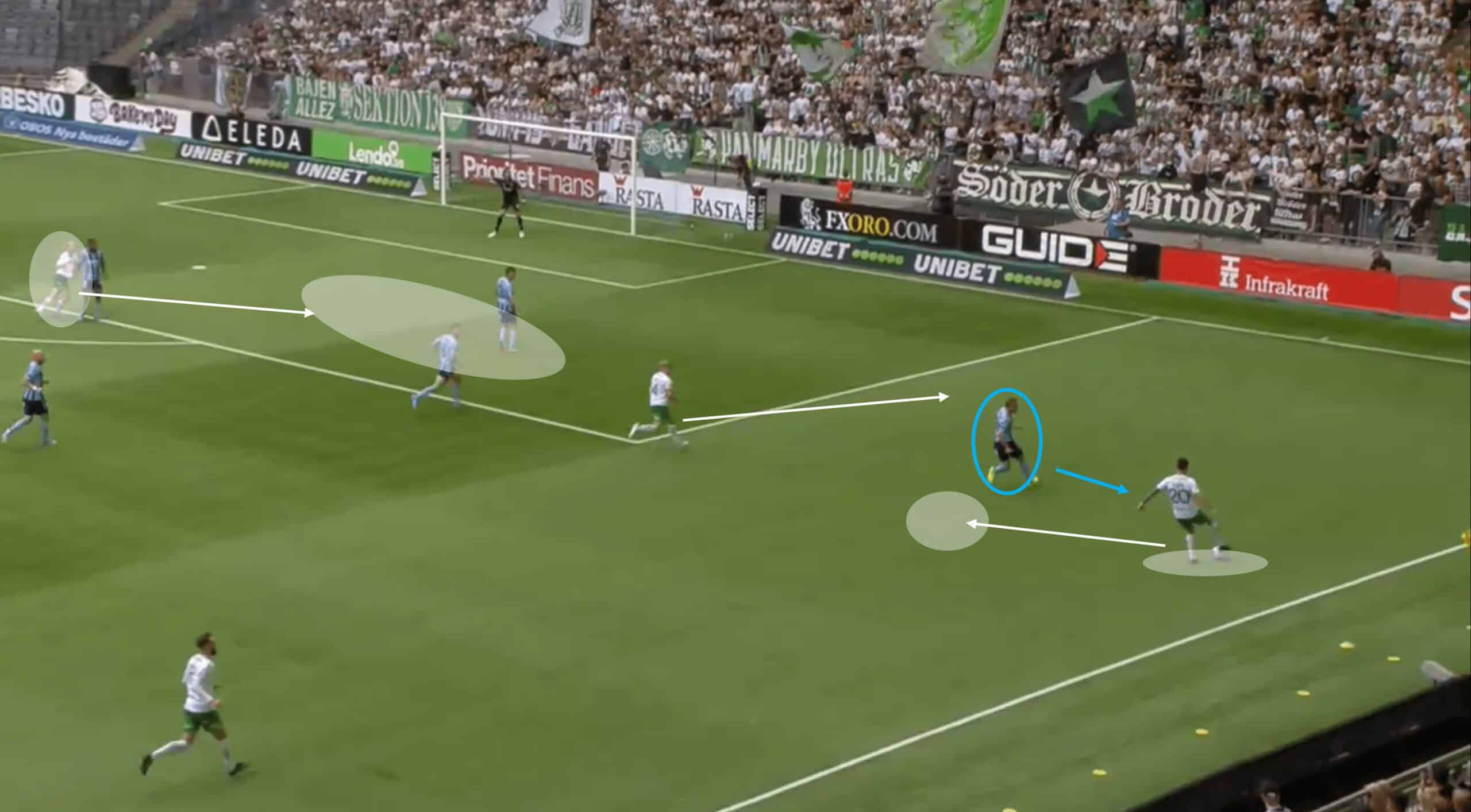




Comments